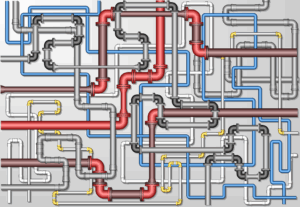Put simply, net zero means cutting carbon emissions to a small amount of residual emissions that can be absorbed and durably stored by nature and other carbon dioxide removal measures, leaving zero in the atmosphere, according to the Net Zero Coalition at the United Nations.
Can you just tell us a little bit about Carbon Negative Solutions and its award-winning mission?
“We’re remediating both air and ground pollution by creating carbon negative cement supplements,” says Crossland. “In a nutshell, we’re taking upcycled industrial waste, which has zero to negative value, and we’re turning it into a high value commodity that’s used in concrete. And this is huge because, again, we’re using carbon sequestration, and we’re also remediating waste by dredging it and using that end product—and creating an end product that is very valuable.”
Your company is not just focusing on low carbon emissions, but a carbon negative process.
“Yes, it’s carbon negative, so it’s even better than net zero,” says Crossland. “When you think of low carbon, it’s great, and I want to tip my hat to everyone working in the space. But with low carbon, that means you’re emitting less, but we have an atmospheric problem now that’s driving climate change. Reducing emissions won’t do it alone, especially with the forces of capitalism where industry and production is growing. If an industry grows a hundred percent production like my industry is expected to in the next decades, even if you reduce the emissions by half, you’ll get to the same place.”
He continues, “Carbon neutral is great. It’s a much better step, but that’s essentially saying you’re turning off the emissions, and just dealing with what we have now. Although that’s an ambitious effort, again, atmospheric CO2 is what’s driving climate change today, and there’s a lag. There’s some atmospheric CO2 that’s still on its way up from emissions that were generated over these last decades. So maybe carbon neutral is not the catch all solution. But carbon negative is the one way you ensure on a unit basis that everything you produce is actually taking from that atmospheric CO2 and getting us to reverse course.”
The Role of Innovation
Sustainable development is certainly a growing industry. Is innovation playing a big role right now in this space?
“It’s huge,” agrees Crossland. “It’s going to take innovation to change. The largest thing to change with anything is consumer behavior or end product behavior. And so given the regulations in the world essentially coming together to drive this change, now it’s about finding innovative solutions that can help us do this. Innovation is going to a have a huge role because it’s essentially taking what we’ve been doing yesteryear and flipping it on its head and figuring out how can we either produce these same things without emissions, or how can we start pulling atmospheric CO2 back and make those things into use for products. That’s all going to be innovation, and it’s going to take a mindset that is almost the exact opposite from the way we’ve been doing things.”
Speaking of that innovation mindset, you’ve had a few other companies and startups. As an entrepreneur, what’s some advice you could give startups about the innovation space and just the challenges or opportunities?
“Most entrepreneurs already have the spirit, but it’s got to be action oriented,” advises Crossland. “A lot of people want to make the technology perfect or it’s very close to them because they’re inventing it and so forth. But the reality is with the pressures and what’s going on in the climate—we have to act now. I would say in this space, to be action oriented, even if your product or your solution may not be perfect. As you go on your journey, you’re probably going to iterate it. It’s going to change and improve, but you have to start. You can’t let the imperfections be a stopping block. Just get out there with your innovative product. Iterate it as you go but get the solution out because we need the solution that’s being worked on today to come to fruition in the next few years.”
That startup mentality that you mention: Do you feel that it’s hard to go it alone or is it really key to have partnerships, whether it’s a big company, a foundation, an academic institution and so on?
Crossland adds, “Collaboration is everything, especially to large challenges such as climate change. And the reality is if you’re trying to really take away carbon emissions and make a dent in that, you’re likely going to need to partner with these large legacy companies that are emitting at scale, creating products or energy that we all know and love and use today. Collaboration in this space is key.”
A Sustainable Vision
Where do you see Carbon Negative Solutions in the coming years? What would you like to see happen?
“Our vision is to become the leading carbon sequestration material and the leading solid waste removal material simultaneously,” says Crossland. “That’s very achievable by just scaling our product up. In the next few years, we’ll certainly be on that journey to do that. We’re looking to turn, what used to be a liability for many industries, their industrial waste, where they hold hundreds of millions of dollars on their balance sheet. We’re looking to actually remove that, help them while also remove their CO2, and again, create our end product, which is a product and the most produced material in the world, which is concrete. That’s really where we’re aiming. That’s really where we’re going. If all is done right, we could really have a serious game changer that, again, remediates not just the air pollution side, but ground pollution.”
Check out the video for more of the interview with Keith Crossland and Carbon Negative Solutions. For more information, visit their website at https://www.carbonegativesolutions.com.
Contributor
-

Matthew Kramer is the Digital Editor for All Things Insights & All Things Innovation. He has over 20 years of experience working in publishing and media companies, on a variety of business-to-business publications, websites and trade shows.
View all posts




























































